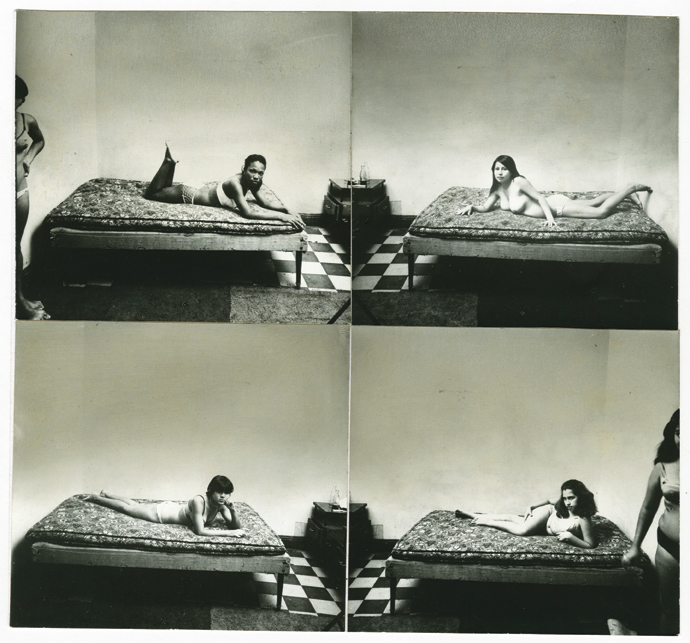« Reviews
Fernell Franco: Cali claroscuro
Centro de la Imagen - Mexico City
Curated by Alexis Fabry and María Wills Londoño
By Irving Domínguez
“Fernell Franco: Cali claroscuro” sponsored by the Fondation Cartier pour l’art contemporain is the first retrospective show of the Colombian photographer in Mexico. The curating partnership of Alexis Fabry and María Wills Londoño decided to create an anthology from eight series that combined two important qualities: experimentation with analogous photography and the detailed exploration that Franco (1942-2006) undertook with the city of Cali, an important enclave in the transformation of the Colombian art scene during the 1960s and 1970s.

Fernell Franco, Serie Prostitutas, 1970, collage, silver gelatin, vintage photograph. Private collection, París. © Fernell Franco. Courtesy of Fundación Fernell Franco Cali/Toluca Fine Art, Paris.
Franco devoted himself to representing with dignity and empathy its inhabitants, who almost always coexisted in decaying buildings, a legacy of rural splendor devoured by the unplanned development very symptomatic of Latin American urban centers. Three series give a good account of it: The first of them, Prostitutas (1972), stands out due to the resolute equilibrium between sensuality and complicity with the task of the photographer. To it are added moments of frankness and total lack of inhibition in the daily lives of the sex workers, all laid out in small rooms, barely furnished, which are sometimes work sites and at others a place to rest. Billares (1985) celebrates Cali’s male hangouts that began to disappear at the start of the 1970s. As the researcher Santiago Rueda has pointed out, the images of interiors achieved by Franco analyze the spatial organization of objects associated with rituals taking place at that locale. Of course, the contemplative atmosphere of the pool halls is cause for interpretation by the photographer, who begins to reproduce the same image utilizing a different treatment: He turns the print or he colors it by hand and even combines both techniques on the same print. Finally, Color popular (1980) is the great revelation of the show. The only series executed in chromogenic prints turns out to be a counterpoint with respect to a production characterized by somber, if not bleak, images due to the canonical use of the black-and-white negative. It is a personal catalogue of the dance halls that spread the cult of salsa, a musical genre that achieved coexistence among social classes and impassioned Franco, because in it he discovered a common language among the artists of his generation. In recording spaces in the light of day, before or after the festive ambience that characterizes them, Color popular appears to complement Galladas (1980), another series about young people on the streets of Cali.
The show turns out to be admirable because of the convergence of so many unique pieces coming almost entirely from private collections. Since Franco applied different techniques to copies of the same negative, it is practically impossible to find two like prints, with the exception of those corresponding to his series Amarrados (1982-1994), which in reality are variations insofar as the dimensions of the print.
It is worth pointing out that the Centro de la Imagen had already presented the work of Franco as part of Contratextos (2008), led by the curatorship of María Iovino. That show presented a panorama of the contemporary artistic production of Colombia, in which a representative selection of his work was presented along with that of Óscar Muñoz, Miguel Ángel Rojas and José Alejandro Restrepo.
(July 27 - November 6, 2016)
Irving Domínguez is an independent curator and researcher. In 2015, he completed a decade of curatorial experience. He is the coauthor of Alberto Flores Varela. Esplendor del retrato en estudio, Nuevo León: CONARTE (2014). He is author of the blog http://usuariobsolescente.wordpress.com/, which compiles his critiques and documentation of his curatorial projects.
Filed Under: Reviews



































Leave a Reply
You must be logged in to post a comment.